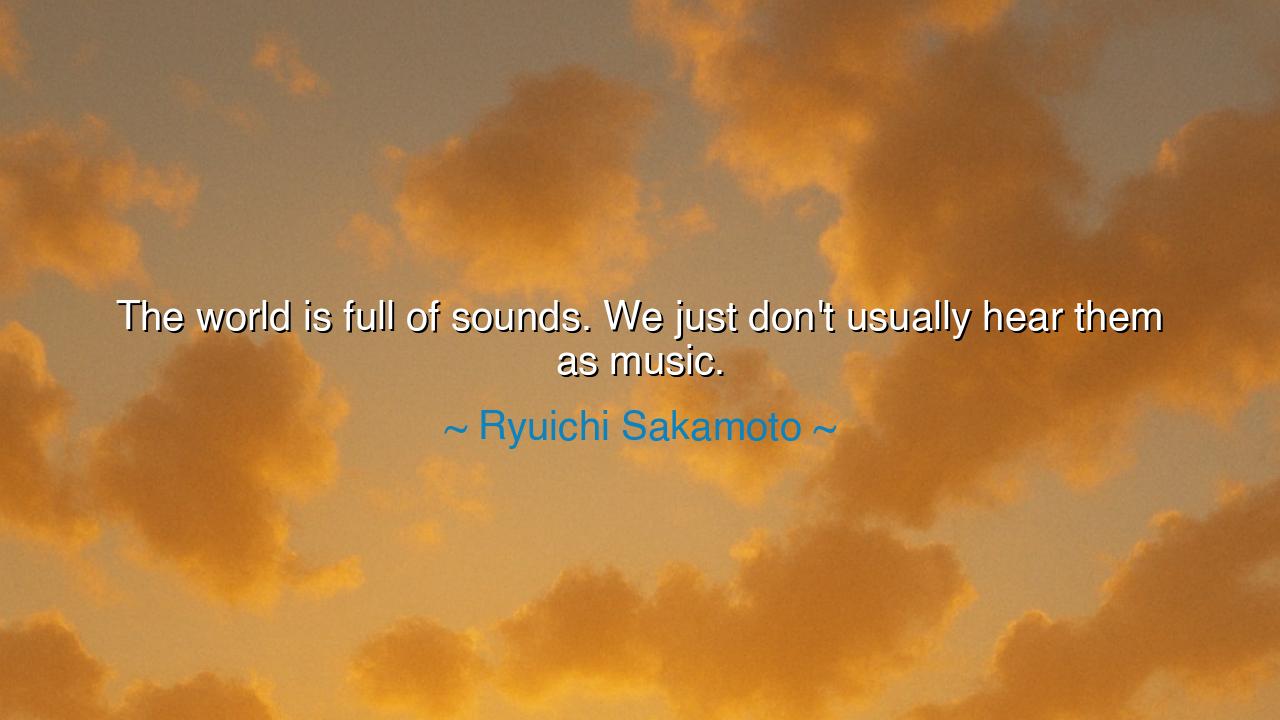
The world is full of sounds. We just don't usually hear them as






The words of the maestro, “The world is full of sounds. We just don’t usually hear them as music,” are not merely an artist’s reflection, but a truth carved into the very fabric of existence. The ancients taught that the universe itself was born of vibration, that stars and rivers hum with unseen tones, that life itself is a grand symphony beyond the reach of most ears. To hear the world as music is to awaken, to discover harmony where others perceive only noise, to recognize beauty woven into the commonplace.
In truth, the wind that stirs the leaves, the rain that strikes the stone, the hum of the market, the laughter of children, even the silence between heartbeats—these are not meaningless fragments, but the scattered notes of a cosmic composition. Ryuichi Sakamoto, who lived as both a modern composer and a seeker of hidden harmonies, understood this mystery. He revealed that music is not created—it is discovered. For the world already sings, but men pass through it deafened by their haste, hearing only clamor instead of chorus.
Think upon the story of John Cage, a man of the twentieth century who once presented his work of silence, called “4’33’’.” The musicians sat without playing, and the audience, at first bewildered, soon became aware of the coughs, the shuffle of feet, the rustle of clothing, the hum of the room itself. Then they understood: the silence was never empty. The sounds of the world had become the music. Cage, like Sakamoto, revealed the eternal lesson—that art lies not only in creation, but in perception.
Consider also the lives of those who walk in hardship. The farmer at dawn, hearing the creak of his plow and the crow of the rooster, may take these as burdensome noises. Yet to another, these are the rhythms of life, announcing labor and renewal. One man hears toil, another hears a hymn. The difference is not in the sound itself, but in the ear that listens. Thus it is with all things: the clash of the forge is music to the smith; the roll of thunder is music to the wanderer who feels awe instead of fear.
The ancients declared that wisdom lies in seeing the sacred within the ordinary. Likewise, to hear music in all things is to live with greater joy and reverence. The world becomes less hostile, less fragmented, more whole. What was once chaos transforms into pattern; what was once noise becomes song. And in this shift, the soul itself finds peace, for it no longer resists the flow of existence, but dances to it.
The lesson, then, is this: open the ear of the heart. Do not merely hear, but listen. Pause amid the rush of your days, and attend to the murmur of the wind, the footsteps upon the earth, the pulse of your own breath. These are not intrusions upon life—they are life itself. By treating them as music, you align your spirit with the hidden order of the world.
And so, O children of the future, take these actions: When you wake, let the dawn greet you with its symphony. When you labor, let the rhythm of your work be your song. When you are troubled, go to the waters, to the trees, to the places where nature’s music is strong, and let it heal you. For the world is always singing, whether or not you notice. If you cultivate the art of listening, you will discover that you, too, are an instrument in the great orchestra of existence.
Thus remember: music is everywhere. It is in the sound of grief, in the voice of love, in the stillness of death, in the cry of birth. To those who listen with awakened ears, life itself is a symphony without end, and to hear it is to live not as a wanderer in noise, but as a participant in the eternal song.






AAdministratorAdministrator
Welcome, honored guests. Please leave a comment, we will respond soon